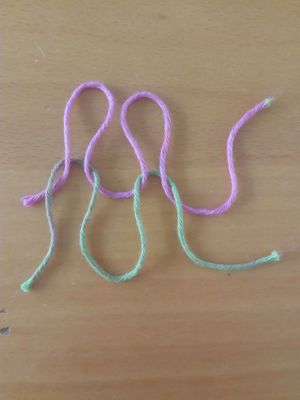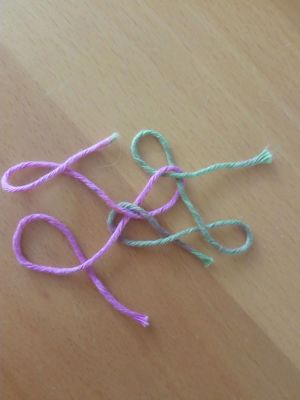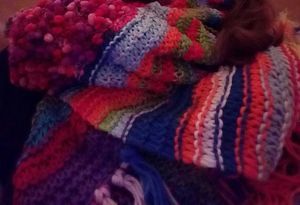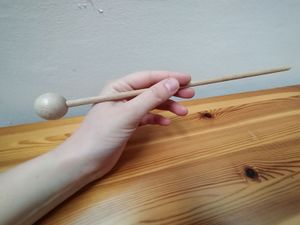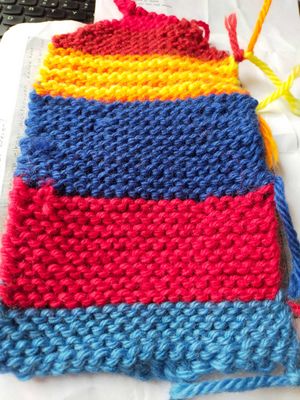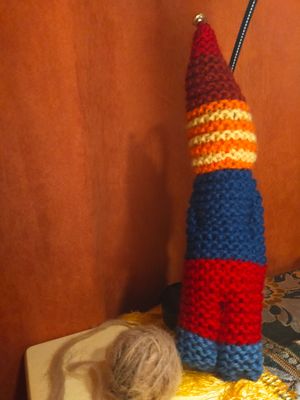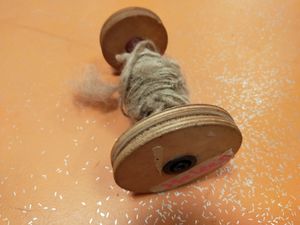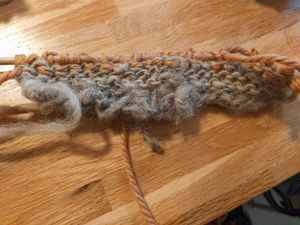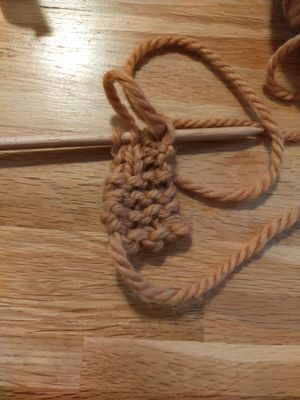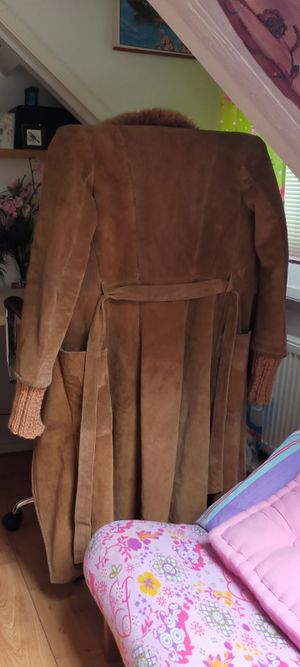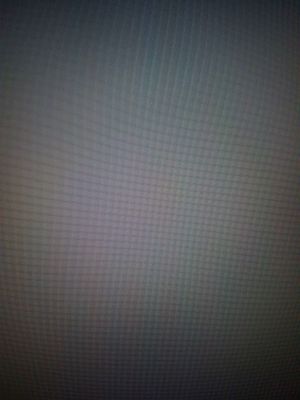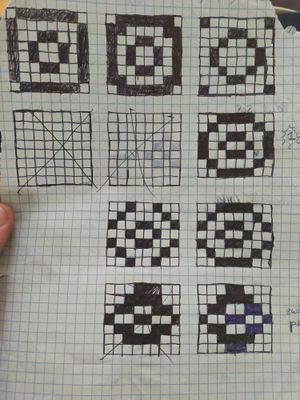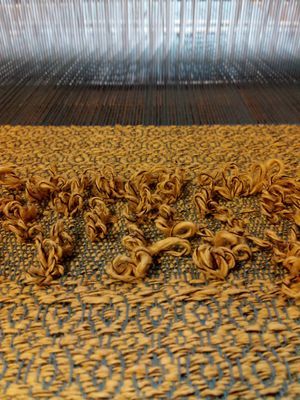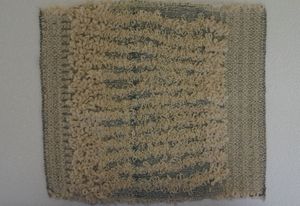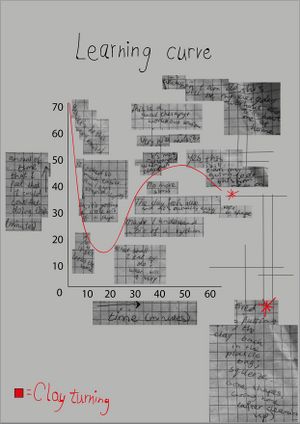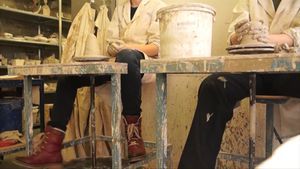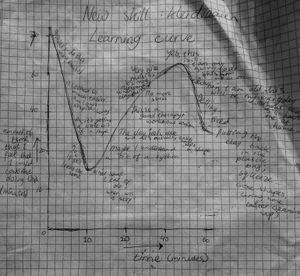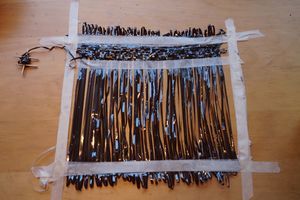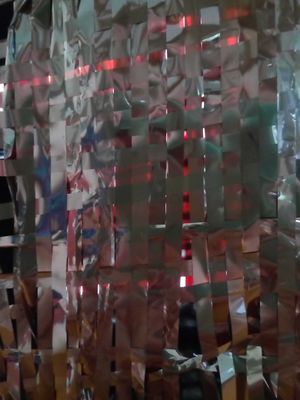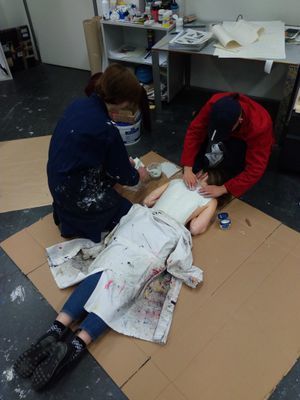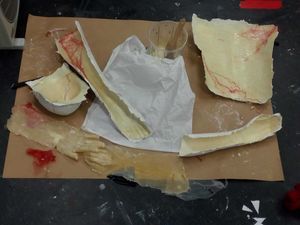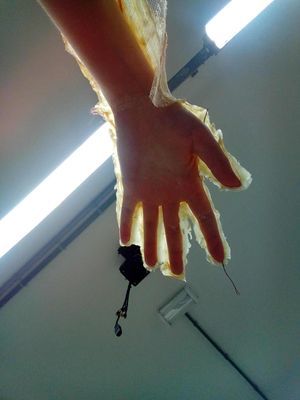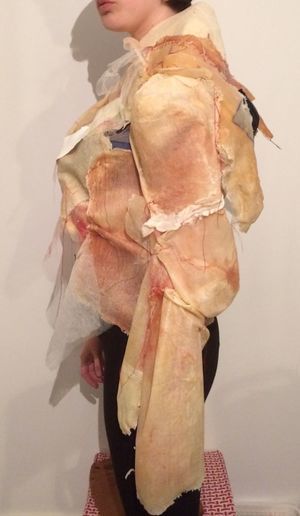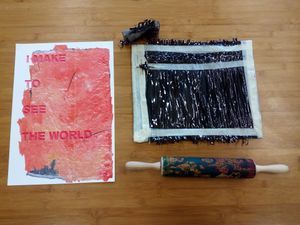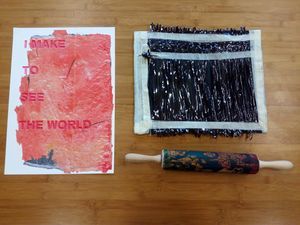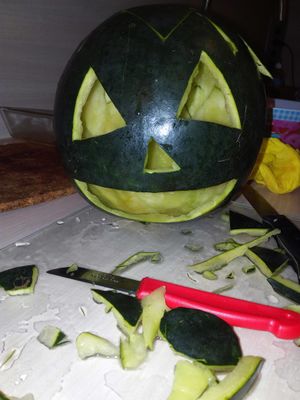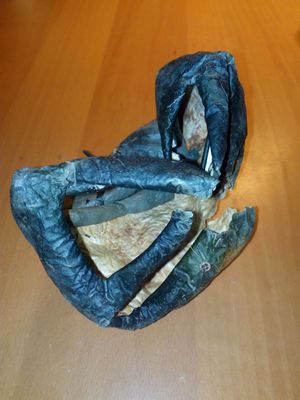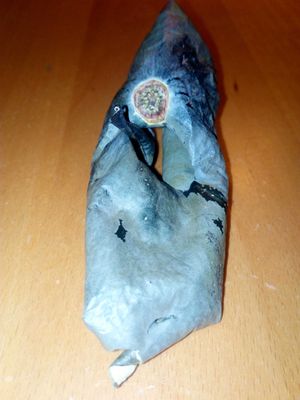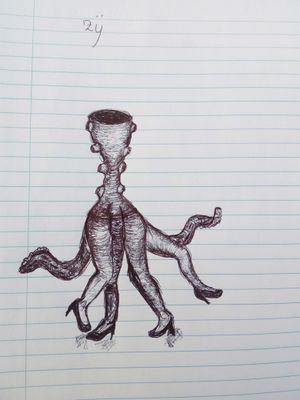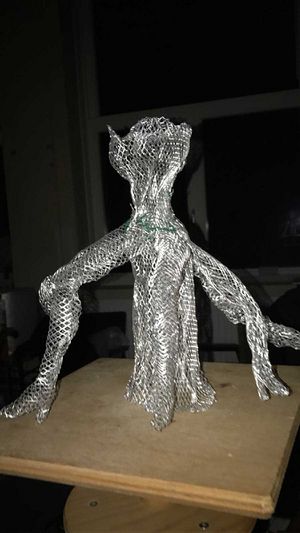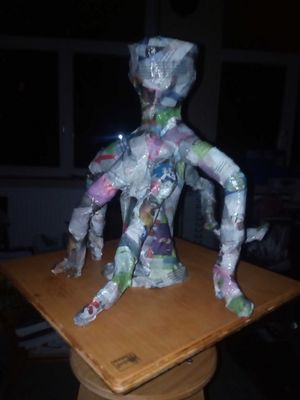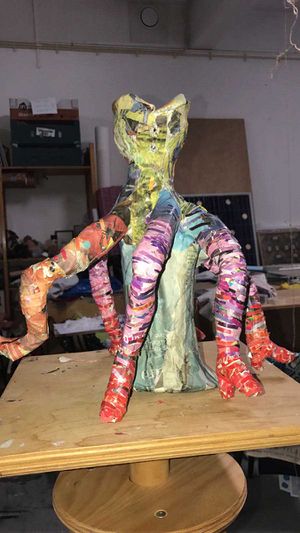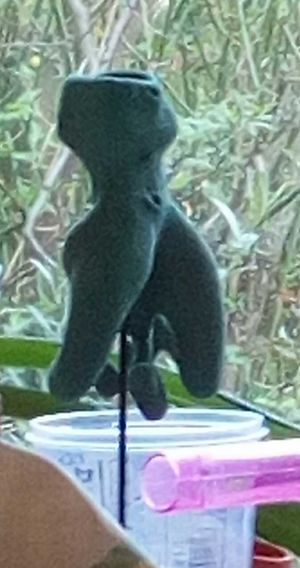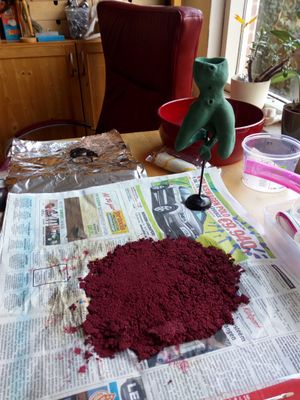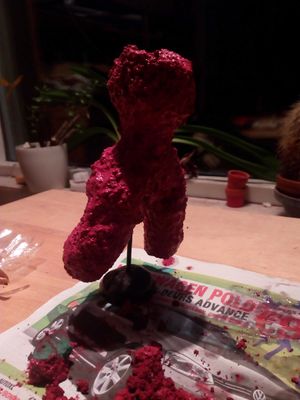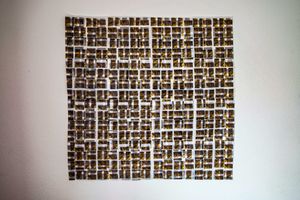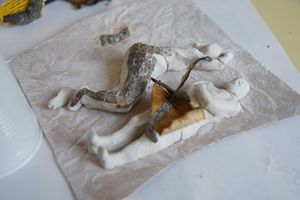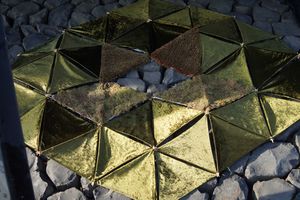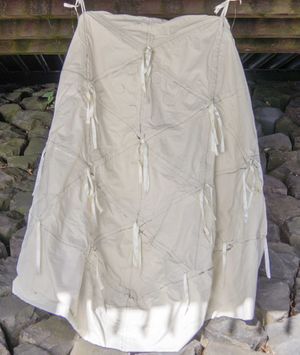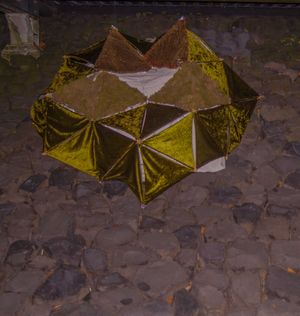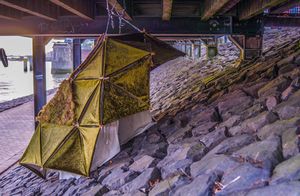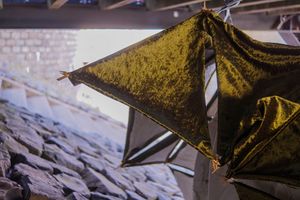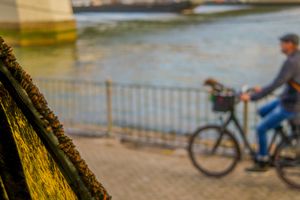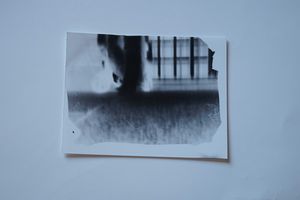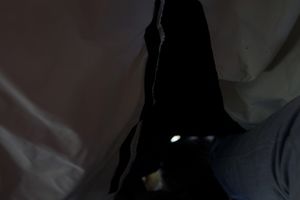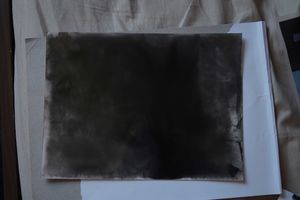User:0904492
Contents
- 1 Digital Craft - Making is connecting 2017 - Wrapping - Heleen Langstraat
- 1.1 Research
- 1.1.1 Theory
- 1.1.1.1 Politics of work and craft - Introducing two pioneers: Ruskin and Morris
- 1.1.1.2 Influence of Ruskin and Morris throughout history: Arts and Crafts movement, DIY movement and craftivism
- 1.1.1.3 Critique on the word “craft”
- 1.1.1.4 The battle of art and craft
- 1.1.1.5 Walter Gropius: Bauhaus Manifesto
- 1.1.1.6 Added notes from the 21st century about craft
- 1.1.1.7 Wrapping
- 1.1.1.8 The history of wrapping
- 1.1.1 Theory
- 1.2 Studio practice
- 1.3 Why I make
- 1.4 Continuation
- 1.1 Research
Digital Craft - Making is connecting 2017 - Wrapping - Heleen Langstraat
Research
Theory
In the practice digital craft we started by reading about different definitions of “craft”. It turned out to be a loaded term, the meaning of which depends on the place and person. The usual status of craft is sadly rather one of low value, because there’s the idea that it would lack intellectual creativity. Craft is mostly seen as the human activity of making objects for themselves and others in the offline, non-digital world ([1]).
Politics of work and craft - Introducing two pioneers: Ruskin and Morris
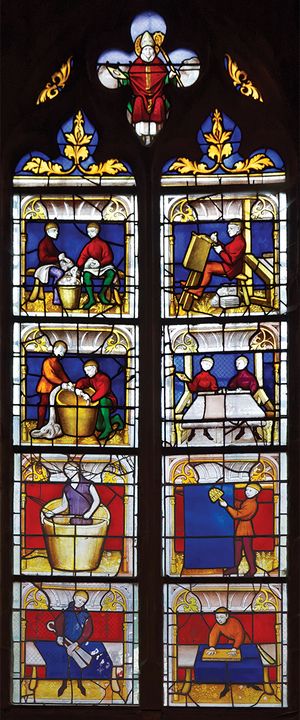
The discussion about craft took shape in the UK during the 19th century. Originally, craft meant something like “sly trickery”, but later on it was used to describe “manual art”, up to a point where it also meant “ability”. “Craft” took roughly three paths since the Industrial Revolution: decorative applied forms of creativity that are generally less valued than “fine art”, something handmade that’s associated with authenticity (of a community) and the condition in which someone works that becomes a priority over the finished product (politics of work). The third one strikes most with the message of Ruskin and Morris.
The Industrial Revolution brought with it philosophical and political protests about working circumstances. John Ruskin, Karl Marx and later William Morris provided their impactful perspectives. Ruskin (1819-1900, born in London) was an aquarellist, art critic and writer, who engaged in conservative politics with an emphasis on the value of community, the value of local organic production and on the care for all workers. Marx (1818-1883, born in Trier) was a master economist and philosopher, who wrote The Communist Manifesto together with Friedrich Engels. Morris (1834-1896, born in Walthamstow, UK) was an artist and entrepreneur, whose socialism is inspired by Ruskin. He aspired to create an art community in which people could enjoy making beautiful objects for everyday life.
In factory work in a capitalist society like the UK in the 19th century, there was a separation between the thinking and making parts. The thinking part decides what others will make and divides the tasks in segments; the makers have become operators. To demand of a person to operate and follow rules exactly, without any personal freedom, is to make one a tool. Ruskin fears the loss of creative and moral spirits: he focuses mainly on the importance of embracing one's creativity in a working environment, which would ideally be freely expressed and individual. A worker should be allowed to produce a whole thing. Ruskin seems to long back to the Middle Ages with their craft in the Labor Parties, because of the ornamentations that showed individual quirks and talents. For Marx this division of labor means a form of slavery, which he uses as an argument against capitalism in his manifesto. A lot of people have a terrible job and feel alienated from it, which leads to products of low quality. The “producers” (thinkers) are disconnected from the making process as well as the operators. Morris practices many kinds of art to produce beautiful everyday objects. He shows that if a person feels in the process that he has the power to leave a creative mark, it will empower the process and usually make an eventual product very beautiful in use and aesthetically: this feeling is the “joy de faire” (joy of making). Though he wishes to inspire many people around him already by letting them experience the beauty of craft, his products are quite exclusive and luxurious due to the fine materials and precise handicraft.
A true making process connects the intellectual with the physical work. Separating ideas from knowledge of how things are made cannot lead to creativity within the making process. When people can add their individual value in a collaboration, then there can exist a healthy community: a community (and hopefully society) that treasures living beings instead of exploiting them. Making things from natural materials is vital for us. The process gives us new ideas that have an influence on our daily life.
The three of them redefine wealth: wealth is about core values, like creativity and nature instead of “growth” or “innovation”. Growth and innovation seem empty and cost people more than they’re supposed to generate. Morris already even made a note that innovation should be used to take care of the environment.
In his book “The Revival of Handicraft” Morris’ vision about industrial production becomes even more clear:
Putting responsibility of production on fewer minds is a way of diminishing general intellect. Though some intellectuals may strive for some form of perfection and look upon machines as perfect executers for their ideas, in return people will forgot what a beautiful object is, actually, next to the handicraft techniques (with the joy de faire). They need material objects and so they will take what they get. After some time they will be used to the standards of this industrial production, while the standards of that production are only a vague middle of the consumers’ wishes. Besides, what will people have to do with all this time, when their handicraft doesn’t seem essential anymore? What will ugly products do for unproductive people? It is desirable is that mechanization will play a dynamic role in some revival of handicraft instead of creating an industry that doesn’t need humans and isn’t for real humans anymore ([3]).
Influence of Ruskin and Morris throughout history: Arts and Crafts movement, DIY movement and craftivism
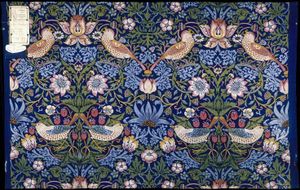
Ruskin’s and Morris’ ideas about work ethos seeped on to DIY culture in the 20th century via the Arts and Crafts movement. The Arts and Crafts movement was blossoming from 1887 till the First World War. This movement aimed to equally value all creative work, because creative workers contribute to a vibrant and dynamic culture by their individual share in production. Making things by hand allows one to connect with nature, a sense of self and other people. Since craft expresses individual life it cannot be taken over by machines with steps nor be divided in a too repetitive method. This vision enabled the Arts and Crafts movement to strongly combine theory and practice with its ideal of “liberation of humankind by communal creativity”. The uniting of work processes with the demand of higher quality of life linked the status of “craft” to the meaning of “power” ([5]).
The arts and crafts movement led to unaffordable products for the typical worker, about whom the movement claimed to be concerned. The high prices of those products were unintended, but the outcome of the time consuming care and materials that went into the products. This paradox led to popularity of DIY culture, into which a democratic element is added by the phrase: “Do it yourself.” This way people don’t have to await a solving of the political system from outside, while their circumstances were actually becoming harder by the rise of prices. Gustav Stickley (1858-1942, born in Osceola, US) was a big pioneer of DIY culture in the UK, because he published his magazine as an open source for knowledge of crafts despite the possible consequences on his own financial situation. The DIY culture was nurtured by a lot of different people: from homeschooling parents, to punkers, to environmentalists and entrepreneurs.
DIY culture in the 1960’s had more to do with a counterculture that refused the content that educational institutions taught children than with today’s associations. Parents and very creative people were concerned that schools did not teach kids any essential elements of life, but rather abstract phenomena that could only prepare kids to become part of a bureaucratic web etc. (Alan Watt, philosopher, phrased these ideas quite well back then.) There was a big home-schooling movement that claimed that adults should give children the freedom to pick their own learning topics and that they should trust that children could build their own meaningful connections with knowledge.
Stewart Brand launched the Whole Earth catalogue in 1968, which offered people a lot of practical DIY information for everyday-life. He was quite an environmentalist (like the Arts and Crafts movement) with his ideals actually. Brand thought that people should see the created picture of the whole earth, to become aware of their own position on earth with limited sources. A person should take up responsibility for the care of the environment and value the connections with it.
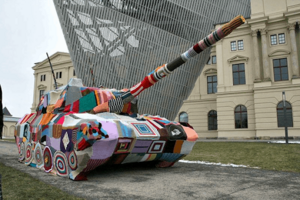
Even though there is the internet, handmade objects remain an important medium to spread the DIY culture. While the internet is a very innovative and quite effective medium, it lacks the tactility of a handmade, physical object for the bonding with it. It also lacks the learning experience of making something yourself instead of just looking at someone else making things. So if “laziness” is an outcome of available information about making processes, then that would be a pity. The internet is much more effective for distributing a subject than via objects. If it isn’t necessary to use sources of from nature to produce a product, it would be better for the environment not to produces objects then. Objects (like zines), on the other hand, feel more substantial; they seem to have more weight as a replacement of main stream culture, which makes them suitable for a variety of topics. The DIY movement has this ethos about anti-consumerism that clashes with the main stream culture: DIY’ers reject the idea that you can pay other people for a solution to all imaginable problems. DIY is more like an attitude than an activity.
In 2003 Betsy Greer even combined the words “craft” and “activism” in the word “craftivism”. Craftivism describes the political choice of resistance made by making things yourself instead of just buying them somewhere. Making things yourself is good for your self-esteem instead of disempowering and you can add a personal side to your objects. It is interesting to see how craftivism can spread a pro-active, positive message, where people usually try “stop that”. Since craft has such a personal influence and representative power, it has the capacity to bring across a rather striking message and it gives people the opportunity to join such a movement. With environmentalism and sustainability (which has to do with autonomy, mobility and social patterns) the fact that the practical part actually binds people with the protected materials enhances the other bright sides of craft. It is easy not to feel responsible for Wicked Problems, it becomes harder when you get to feel more connected with the environment.
The spirit of craft can also become visible in other ways than a direct physical manifestation. To help create sustainable social patterns, craft can be redefined as daily human behavior that we practice with each other on a daily base. So everybody is crafting already and we are the material, but we can become more aware of that fact and how we make a difference thus. We can start crafting gentleness with friendlier values than the harsh “right” or “wrong”, that put some people in a bright spot an others in the dark. Values like “helpfulness” and “appropriateness” might help. The power patterns can change. The society doesn’t have to look like a closed, unliving system in this way. Craft doesn’t have to mean hands on, but it occupies all interactions with nature (including people).
Critique on the word “craft”
When Ruskin and Morris were discussing “craft” in the 19th century, “craft” already had a conservative reputation. If craft is fundamentally the opposite of the processes of modernization, then handwork could only have a small impact on society within a capitalist economy. People still believed that craft could have multiple functions though: craft could function as a retreat (a withdrawal from modernity), craft could soften the hard edges of the modern daily life or craft could take a role like fine art. The following could be corrected or used a footnote by Ruskin’s and Morris’ texts: apparently there were more artisans in 1850 than in 1750 actually; “labor aristocracy” happened already in the Medieval Ages, when highly trained craftspeople defended their privileged position in the Medieval Ages; the new mechanical tools from the Industrial Revolution enriched a lot of production processes that still entailed handicraft and the making of industrial tools and machines depended on craft.
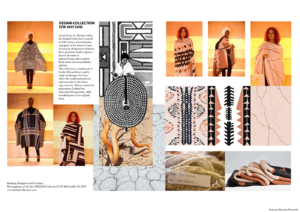
The term “craft” was invented halfway the 18th century already as an attempt to position the power of hand skill as a supplementary one, because from then on it seemed possible to categorize craft. Actually it was common knowledge back then that artisans could practice a powerful form of control. Halfway the 18th century a shift took place in artisanal workshops: the division and specialization of labor, so that the executer would start to be seen as “generic”. Craft gained the meaning of only a possible part of a production process. In other words: the division of labor started before the Industrial Revolution and actually had to do with the mystical power of hand skill.
Some tractable materials like cast iron, papier-mâché and rubbers were seen as so plastic, that people have believed for a period that designers could model them with their mind. Inexplicable things (like craft or magic) used to hold great cultural status. Now people are afraid of them and want something that they think they can control with words. Writing about craft was used by Victorians as an attempt to diminish the control that craft had. Fortunately for craft, it is very difficult to “explain” craft and undo its “manipulative structures”. The amount of publishing of craft in the 19th century far transcended the utility. Instead of artisan’s endeavor for “mystery”, somehow there became one for a “self-serving form of explicit description”.
Before the industrial revolution and outside of Europe and America, one could not even speak of craft as a separate field. Any serial production needed a lot of hands. Since the term is quite new and from Europe and America, the term might suggest that before the second half of the 18th century and outside of Europe and America there haven’t been stories of transformations within processes of production- it would all “just” be “craft”.
Craft was actually a prop to promote imperialism. Colonizers used what they considered craft as an antithesis of industry. A clear contrast started appearing between the influence spheres of imperialists with their industry and the areas where colonizers had no influence. Industry was seen as “inventive, progressive, technological and efficient”, while craft was considered to be “static, trapped within tradition, slow and intuitive”. Modern ways of manufacturing were considered to produce “superior quality”. To craft the reformers assigned some positive qualities too, like “creativity, rootedness and authenticity”. Talking about “others’ authenticity” suggests a description of “other” culture from a Eurocentric view. They idealized ways of living of people that they considered to be outside of their own culture, while “reforming” their religion, manufacturing, and everyday life. Many Europeans and Americans considered their vision of improvement as something that’s necessary to be civil. In this sense the invention of “craft” is in the end part of modernity ([8]).
The battle of art and craft
The concept of craft only took its defined shape, when other crafts decreased by the industrial revolution and mass production. The two concepts- industrialization and craft- are opponents that create and support each other’s meaning. The concept of “craft” and “art” define each other in the same way: “craft” makes it possible for “art” to take its position.
Craft can be looked at as an idea, category, more loosely than as just things that are handmade in a certain medium. Craft can be considered as a quality of which every artwork consists. Craft has created its own cultural and economic value though. It would not be fair to put craft under the term “art”.
There are three main so-called differences between art and craft: a modern artwork is usually considered autonomous, while craft is seen as supplemental. Art is more about optical effects, where craft is more about the material experience. Skill usually plays a bigger role in craft than in art, because skill shows that craft is rather an active, relational concept, where art seems to be more like a fixed category.
Craft has its own boundaries and is more defined for that reason. The separation with art makes it easier to look at craft itself. Art can be aggressively autonomous: “don’t touch me”, so it can be easier to relate to a well-crafted artefact. Whether something falls into the category of art is most of the time depending on external factors. The autonomy of art is therefore debatable ([9]).
Walter Gropius: Bauhaus Manifesto
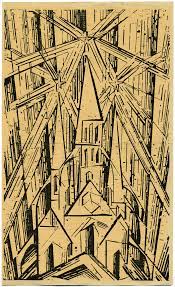
After WWI many people in Germany believed that the artist could contribute to creating a change in society by making new visual surroundings. The Bauhaus in Weimar became the center of this attempt, not just of Germany but of entire Europe. Walter Gropius (1883–1969) wrote the Bauhaus Manifesto in 1919. The central point of the Bauhaus Manifesto is to unify all creative effort by creating an organic learning environment that is open for anyone to join. When someone wants to learn to master a craft, one can get educated by craftsmen and maybe learn how to make art from that base. Art by itself has pretty much lost its unity, which makes sense, because art has transcended all methods. Craft however can be taught. In craft lies the prime source for creative imagination.
The Bauhaus Manifesto has a geometrical church as an illustration. This illustration is emphasizing the metaphor of the unification of creative processes as a building: all the parts should be appreciated by themselves, as well as in the shape of a whole. It looks like a church with shining stars, which might stand for the sublime power that might be achieved this way. The three stars represent three important arts: painting, architecture and sculpture. Just like a Medieval cathedral the Bauhaus as a building became a meeting place for all education in fine art.
In the first years of the Bauhaus Walter Gropius was influenced by the ideas of William Morris and the Arts and Crafts movement. Gropius writes about the importance of returning to the crafts and creating together, just like Ruskin, Morris and Marx. He also wishes that the value of craft would be recognized. Beautiful objects can only be achieved by crafts.
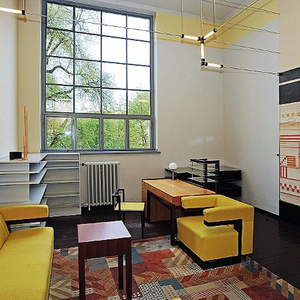
The term Gesamtkunstwerk is introduced. Gesamtkunstwerk is an architectonic concept. It means that an architect wants the entire building to be a whole. For that reason he designs and makes the interior as well as the building, e.g. wall paper, furniture, flours and decoration. Around 1922 however the ideas of the Bauhaus took a shift because of the influences from De Stijl. The Bauhaus moved towards a cubistic simplicity and functionalism, especially in the field of industrial design. The Bauhaus had to design for mass production, because otherwise the designing was financially impossible. In 1923 the new slogan was “art into industry”. The focus on craft remained though. The learning environment of the Bauhaus did away with the hierarchical, rigid structure that craft faces elsewhere. A part of the concept of “craft” has been to have power in one’s own hands define itself, but in the Bauhaus that wasn’t completely possible, when it turned out to be necessary to design for mass production ([12]).
In 1928 the new director of the school was Mies van der Rohe. Mies van der Rohe and Walter Gropius moved tot he USA and spreaded there ideals there. The school was closed in 1933 by the nazis. Architects of the Bauhaus found their refuge in Tel Aviv (Israel), where they built the White City ([13]).
The art and design education of today has been influenced by the Bauhaus. The Bauhaus has no real hierarchical structure of art and craft and there are no real authorities in the institutes. There are mentors and facilitators of students. Bauhaus was popular in the art and design education in America. The focus in The Bauhaus laid on the growth of the artist who designed products for the whole society that were industrially made. The Bauhaus brought design to the social status of fine art and embraced the new technologies that came with the machines for this purpose. This was a time with big other changes too: there were new social power structures in the working environment, new concepts of beauty (the most intimate personal views in expressionism and the abstraction in constructivism) and a shift away from social classes in society. The Bauhaus and Black Mountain College merged the ideals of the Beaux Arts with those of Arts and Crafts. Design and all arts were equally important to enrich and improve the society. From psychology and sociology came the concept of the importance of individuality and artist perfectly knew how to represent that. “Teachers do not work according to any predefined definition of art, not even their own, but rather challenge their students, discussing with them concepts which call into question artistic traditions as well as social norms and values. Institutes which now serve as models for others, do so based on their curriculum and the professional reputation of their teaching staff. An institute’s success is not based on its educational philosophy and underlying definition of art, but on the subject matter of the curriculum and the reputation of its teachers and alumni” (page 13; ([14]).
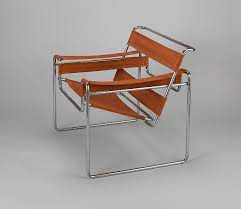
Two of the directors of the workshops of Bauhaus were especially popular: Marcel Breuer (1902-1981) and Gunta Stölzl (1897–1983). Marcel Breuer directed the cabinetmaking workshop from 1924 to 1928. The Bauhaus aspired to deliver prototypes for the mass production of everyday products. This pursuit was best accomplished by making furniture. Breuer made a chair that was one of the most important products of Bauhaus. His chair connected conceptually with Gerrit Rietveld. Breuer and his studio looked for the chore of furniture, which leaded to minimalistic chairs and dreams of the most lightweight chair. The chair that Marcel Breuer created in is still being made today and was inspired by his new bicycle. Gunta Stölzl directed the textile studio. She and the studio took the character of weaving from a supplementary one towards a broader art. They researched color theory and looked further into possible shapes with weaving. Stölzl and her studio maintained the Bauhaus a lot financially with their sales. Their textiles gave the interiors of the Bauhaus a colorful and abstract optical effect. In the studio there was a lot of experimentation with materials like cellophane, glass and metal. The studio was run by mainly women. Women were actually not really accepted in the other studios. Though weaving had been kind of an unnoticed art with bad working circumstances, Stölzl took it with the students in her studio to something with status. Anni Albers (1899-1994) was educated here and became an important textile artist. She was inventing and writing about contemporary fabrics for a big part of her life ([16]).
Added notes from the 21st century about craft
The development of software offers a new medium to create visual artifacts. Though this medium is not exactly tangible, the creations are still a result of the relation between hands and the mind. The personal making processes in digital media keep the human touch alive in architecture, painting and modeling for instance. Hand-eye coordination, the image culture, the tools and the interaction with an interface play a role in those processes and improvisation is often necessary ([17]).
There is also a manifesto about ownership of products that has to do with making and repairing. Product should be designed in such a way that the user can repair it, if it’s broken. It should be possible to replace parts and open it up without making it completely useless ([18]).
The making culture can be quite dominant nowadays and focused on a traditionally male role in society. The fact that one makes beautiful furniture for example doesn’t have to become the thing one is known for. It is also important to actively appreciate work that doesn’t produce objects for sale- like the work of teachers and caregivers ([19]).
Wrapping
During the practice Digital Craft all students were in a group that would explore a making technique. I was in the group “Wrapping”. In wrapping our goal was to produce samples of machine embroidery and knitting, to research small-scale textile production and tinker with electronic textile techniques. The definition that we used of wrapping during the course was: a technique to construct (textile) without irreversibly changing the used material. The biggest examples of wrapping are knitting, weaving, knotting, binding, sewing, tufting, twisting and twirling.
The history of wrapping
The biggest influencers of the modern textile production process have been: Siberia from ca. 6000 or 5000 B.C., the Chinese textile manipulation from around 3500 B.C., the Egyptians from the first century B.C. and the Europeans form the fifteenth century during the Renaissance onwards. Textile usually functionates as clothing, shelter, ornaments, art or decoration. Some textile techniques are also necessary for creating baskets, hunting, pulling something heavy, binding and climbing. Especially clothing is strongly related to culture.
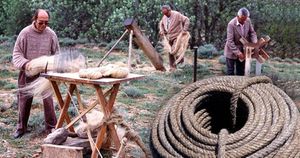
“Wrapping” usually starts with a thread and a needle. The most common thread is the thread that’s created by a technique called “spinning”. Spinning is a technique, where fibers from usually wool, flax or cotton are twisted to create a thread. An important tool for this process is the spinning wheel from 500 A.D. in Asia. Before the use of the yarn from spinning people used animal parts, like veins, sinew and catgut. The bones were used to create needles. In Africa people combined sewing with weaving leaves to create baskets. Organic ropes (like lianas) were popular. The ancient Egyptians made rope from papyrus from 4000 B.C.. There were also ropes from date palms, flax, grass, leather and animal hair. From around 2800 B.C. there was the Chinese invention of rope made of hemp. This invention caused a great spreading of the craft of rope making from Asia to Europe.
In England and via Europe and America, the Industrial Revolution (from 1750) brought upon people the invention of a working sewing machine and other textile machines, like those for embroidery, weaving, crochet and knitting. This gave the means for an economic development, because it was suddenly possible to produce a lot more quantity on a working day. For housewives the new sewing machines helped them to do their cores more quickly, so they could actually look for employment. In that way they could even provide more for their family. The fact that making clothes and shoes took less time from employees, made the clothes and shoes less expensive. In time the sewing machine also became cheaper. Low prices for ready-made clothing eventually concurred away making clothes at home, except for as a hobby or for if the clothing is very detailed.
The clothing industry affected the manifestation of culture and multiple industries: the expanded need for cotton demanded more cotton fields, more (metal for) needles and transfer. Plus there is replacement of employees by people in countries with lower costs- thus there has to be more international transfer, like shipping. This especially happened when synthetic fibers were getting more and more common in the 20th century. A lot of ruling technologies in the fashion industry are “Western”. (The patent on an invention can be bought or demanded, plus the technologies are at least executed mainly by people in Asia nowadays.) [21]
Studio practice
Historical example
My studio practice has started with the old making technique knitting. Knitting is the process of making a textile out of one thread with multiple needles. Knitting originated from single-needle knitting: creating loops with a needle and pulling a thread through each loop to create a new loop in order to create a fabric of loops. The oldest found single-needle knitted fabrics are from the 7th century B.C. from Israel. Knitting was usually necessary for making clothing. The oldest pieces of clothing from single-needle knitting that we know of are from Egypt: socks out of the 4th century A.D.. Between the 11th and 14th century there were socks that were knitted with multiple needles in Egypt. Later on in the the Middle Ages the technique of knitting spreaded towards Europe, probably via Spain that was dominated by the Moors.
When I think of wrapping I firstly think of wearing clothes and quite soon after that I think of the clothing industry. In the clothing industry the fabrics are usually either woven or clothes are fabricated by a knitting machine. I was surprised, when I learned that T-shirts are quite often knitted. I actually used to associate knitting with someone doing a relaxed, inward activity that would eventually produce something quite expressive.
As my first example, I’d like to show a scarf that I’ve knitted. For this long scarf, I’ve made use of the weft knit (Single Jersey/ plain knit). In the photo you see the reverse of the fabric, as I wrapped it around my neck. I’ve chosen wools with a variety of thickness and a lot of colors. When I stumbled upon these wools with multiple colors, knitting was new to me. I was very enthusiastic and curious to see the yarns unwrapped to look at the color transitions. I wanted to make something with it and knitting seemed a good start to make something with a lot of wool at home. It was nice to start knitting a scarf, because I could get adjusted to the movement with my hands and arms and enjoy the process of the scarf growing. I didn’t do purling yet, but I attached multiple wools to the scarf and finished it by creating fringes with a crocheting needle. My mother and grandmother actually taught me how to knit. For my grandmother it actually used to be a necessary activity to knit sweaters. Now they were helping me to learn to knit more like a hobby. My scarf became large and it turned out to become quite an expensive project. My friends liked the scarf and it was so tall that we could share the scarf. One friend said that I didn’t knit it as one is supposed to knit a scarf. I actually enjoyed the attention the scarf got, because I put a lot of attention it for some weeks. I vaguely associate the result with “yarn bombing” from the 00’s onwards, as shown in the picture with the tank. While making this, I really started to feel how much of a connection I can have with a “product”. Even though such a scarf might not “match” with quite a lot of clothing and I made the mistake of giving it no variation of stitches, I like its softness and its quirky colors still make me smile.
As I don’t have pictures of the knitting process and I feel like I should show some more for this practice of diving into the old making technique knitting, I’d like to tell about textile classes I followed after the practice.
After the practice I was following textile classes, when I was studying to become a Waldorf elementary teacher (but I followed only the first year in the end). In these textile classes we got assignments to learn the history of textile production as well as practical basics. We focused on knitting. With a spinning wheel I made my own thread after carding the wool. Later on I made my own needles from wooden sticks. I sharpened the ends of the sticks and glued a sphere on the other side. Then I tried to knit with my own thread with my own needles. Later on I’ve made a gnome with these needles. I decreased and increased stitches, changed wools and did knitting and purling. This is a gnome that children usually in the age of 6-7 make and that we made too to understand what they might experience better and what they might need from us (as a teacher). The gnome is usually the first piece of knitting that people within the community of Waldorf produce. Making a creature some (young) people belief in and which is famous from folklore tales by knitting is quite a balanced activity in the sense that one works with the hands, heart and the head. To create the shape of the gnome one has to count stitches and thus focus. The gnome is a often loved creature and can become exactly how you’d want it to be. You can get attached to it quite easily by the knitting process. Knitting is also a good motoric practice to stimulate the coordination that is needed for writing for example.
During these textile classes I came across this beautiful long leather coat with a fur collar in a thrift shop. When I tried it on, I immediately saw that the sleeves were way too short. I decided that I would knit the sleeves by myself and that I would look for the wool in my home town. To create the sleeves I was practicing in a new way with alternating knitting and purling. Again I felt extra attached to the coat and what I knitted than I usually feel attached to clothes.
I consider the outcome of the assignment of the historical example mainly as a warming up in the end. What it did bring me was a fascination for the movement of the thread during a making process and some fantasies of being a part of that thread. As I enjoyed this excitement I did want to find a way to bring that experience more clearly across in future outcomes. I also visited the fabric station to see the knitting machines and try them out. I found them quite complicated, but was hesitating for the next example whether I would choose knitting or weaving. In the section comparative example, I shall tell more.
Comparative example
Within this experimental example I compared different techniques of weaving and I tried different materials. Weaving is the technique of constructing a fabric by wrapping a horizontal thread across vertical threads that are usually fixed. Until the sides of the fabric are sewed a weaving can be unwrapped without the material being changed. I was interested in weaving because this technique is very important to create textiles that are necessary for the clothing industry. I hesitated between knitting with the knitting machine and weaving on a computer driven loom. Eventually I made my decision based on my wish to create a wrapped textile with a cuddly appearance by either knitting or weaving. The cuddly appearance seemed better manageable with weaving and creating loops than by working with the knitting machine. The weaving loom itself also spoke to me more at the time.
During this practice I was fascinated by vivid and lucid dreaming. When I had this type of dreams, I could feel trapped into them and during the day I would hesitate whether I was truly awake. This hesitation especially happened, when I woke up in a new dream after dreaming. It scared me that something might be wrong with me for a while and it came along with some nightmares at first, but I’ve read that only the fear of having a lucid dream and postponing my sleep is sort of destructive behavior. During the day I would do “reality checks”. It took some time to find something that distinguished my dreams from my waking state. It started by asking people whether this was a dream and that started some conversations about reality and (shared) consciousness. It was a bit difficult to trust that I was awake and I was also a bit careful in my dreams, because it might be reality and my actions might have actual consequences. At some point in my sleep I was flying away from a light nightmare on purpose and I felt extraordinarily happy.
The conversations about consciousness, reality and dreams led to questions about the nature of dreams, psychology, which part of reality we share and even about biology. Though these conversations with friends were kind of intimate, they also made me think that we could never know what somebody else experiences and I felt like too many things were all questionable all of a sudden. I started hesitating sometimes whether I was actually living my life, while I always stayed convinced that I was.
Out of these conversations came some hypotheses about the differences between the waking state and the dreaming state of mind. Along with those hypotheses there were also ideas about how to relief myself from multiple vivid nightmares in a row. In the waking state other people would have a conscious too and that is something that I would have to take for granted. In my dreams, a friend told me, friends could only behave as I expect, fear or hope them to do, while in the shared reality they are more unpredictable. Another friend said that I should look at my hands and that it would not be possible to see them in a dream. What worked quite easily actually was to check whether I got out of bed and whether I could remember getting in. The natural laws and time are also helpful. When there is a nightmare and I realize that I’m dreaming, I can tell myself that I am safe and in control. What would I want to happen? We talked about nightmares too and about learning to accept your own fears. I could look my fear in the eyes, observe it, listen to it, but understand that the fear on its own doesn’t have the power or will to do me harm. It is something I am creating unconsciously. I can give it power unfortunately to grow and block myself. Being afraid of the fear and avoid fearful events makes the fear worse, while getting to know it and letting it be has helped me from time to time. To get familiar and maybe even comfortable with some of my fears I wanted to visualize them and make them very tactile- as if they might even have some kind of minor personality. When I watched the French movie “Le Tout Nouveau Testament” (2015) about the daughter of god rebelling against him, I noticed that I felt very uncomfortable and by the idea of being observed as a few pixels and easily controlled by a god (from behind his computer). We could easily be overlooked and hurt as some pixels, which triggered some fear. I started trying out this assumption: When the screen is showing only a glitch or snow, then we might lead an unpredictable and unprotected life. Together we would create a moving image that seems almost white from a distance and isn’t telling any of our stories by itself. When there is a glitch in a movie or on a picture of a screen, a pixel is actually more outstanding.
The idea of being part of something that is displayed on a screen wrapped itself around the hesitation I sometimes felt about whether my friends were my actual friends or just part of my dream. What if all the creatures in my dream have a consciousness too and I am part of another consciousness? What if my life is just part of somebody’s dream and my thoughts aren’t mine?
In the fabric station was a computer-controlled, manually-operated weaving loom. I thought it was interesting that the weaving patterns on this weaving loom are now controlled by a modern computer, because the design of early computers is actually based on punch cards for weaving patterns of the Jacquard loom. From a huge mathematical tool a computer developed towards an immersive screen with a lot of- almost hidden- technology behind it. The screen and a woven fabric both have a clear grid. It looks like the thread has been replaced with a flash of light on a computer screen. By weaving the glitch, I might freeze this moment where I consider the “pixels” to be finally “free from the grid”, but out of control. Can the “pixels” (people/threads) be autonomous, but work with the structure of the grid? Can the grid be a pleasant place? I can frame this fear into a rectangle and keep my mind focused on the movement of the slow weaving process. The grid might be a parallel with the natural laws or with different (sub)cultural perceptions. The (vertical) warp threads are the rules around which we move. After I practiced weaving a pattern on a smaller weaving loom by hand in the fabric station, I alternated Tabby weaving with a drawn pattern that was controlled by the computer next to the weaving loom. For the pattern I drew something that made me think of a drop in the river that repeated itself. In the fabric station there was a very thin and soft thread from wool. With this thread I mimicked an empty white computer screen and eventually I came closer to mimicking the glitch. I used white, red, yellowish-greenish and greyish blue. I was pulling some threads loose of the weaving to make it more tactile and quirky. The weaving process was kind of hypnotizing. Because I was looking at the fabric a lot, I thought that I knew every detail and it looked like a landscape to me. Though I was weaving one long piece of fabric, I was thinking of making two pieces of textile from it. The first piece of textile was the part with white wool. This fabric was the one I associated the most with a screen in the end. I projected a Charlie Chaplin movie on this “screen” with an old film projector, because I liked the idea of the film being a wrapped material by itself too. To me the screen has a bit more of a “personality” of its own now and it reminds me of glitchy images. I also liked to see the combination of an old movie and my new “screen”, because it gave me a new impression of the silent film. [insert image 1]
The second part of the fabric was part of another idea. The fabric could react to an audience. I liked it if the weft threads wouldn’t agree with being fixed in the warp threads. I liked to show that the threads of the fabric were affected by someone closely looking at them, as if they were allergic. If the fabric looked like a hairy handkerchief with yellowish and green, it might be possible with wind or movement and sound to make it look like someone is sneezing in the “handkerchief” as the screen is approached. [image or movie perhaps, movie is awkward though as I’m in my pajamas and very seriously tried to be two persons in 30 seconds]
After finishing these fabrics and creating short videos with it, my interest in the invention of film grew. The invention of film rose from a technique that involved wrapping images rapidly and film developed towards the digital medium. The manipulation of light has become quite untraceable for the public eye. A camera has captured some light and sound, but not the material itself. When someone watches the movie, they can experience a story very intensely though. The immersive character of film makes the film making process a good metaphor for the arise of a dream.
A dream originates from processing sensory stimuli during the day. During the day it is slightly possible to control thoughts. When asleep, the thoughts are wrapping or fusing. I want to create an image of this thought wrapping. To create this image I make a video of the weaving process from during the practice and print all the stills on transparent paper. The video of the weaving process consists of a lot of repetitive movements with slight differences. The material is very visible and even in the stills the fabric look tactile to me. With the printed stills I start a new weaving process. The tactility of the fabric in the images gets pretty much lost, but the new fabric is tactile in a new way. This idea from during the practice is something I continued after the practice and it seemed like it could be an infinite loop. For that reason I will show it in “continuation”.
Example of a new skill try out - learning curve
https://vimeo.com/329546992 password: practice22017 performativity/repetition of movement, only still captured by film. Connecting with music/ideas through medium/material. Wrapping, because clay turns around and inside hands, but if left wet, it stays the same after all. Can be reused. There is no product; it’s about the process. Our heads don’t matter for this, because our movement and the music should give you enough impression of the working/playing experience in this environment… the different shapes in video also show different possible outcomes (if it would actually be left to dry), but remain part of wrapping process. Can it count? Can we connect something else than the dry fabric to the wrapping?
Horizontal axe: time (minutes)
Vertical axe: amount of time that I feel that I could continue doing this (minutes)
- (0,70) yes, let's do this. Very excited!
- (5,50) It looked so much easier... Am I this stupid/clumsy?
- (8,30) Oh, it's getting a little bit of a shape
- (10,20) Now it still looks the same
- (22,18) What shall I eat or do? When will I stop?
- (25,25) Maybe I understand a bit of a rythm
- (30,32) The clay feels alive and it's actually easy and soft to shape
- (32,38) This is a good therapy + work out session
- (34,40) Very nice music
- (36,42) It's more outstanding, when clay turning
- (38,43) No more stress
- (48,49) Yes, this is it... I am only going to do this from now on.
- (60,40) Even when I am old, this will be my everyday work out and I'll have one at home...
- (80,10) tired - putting the clay back in the plastic bag; squeeze... Gone shapes. Going home (after cleaning up)
Example of a material pushed to the limit
Casette weaving (was in line conceptually with comparative example..)
Foto gemaakt door Robin van modeafdeling en bijgesneden door mij Opdracht: Voor de practice Digital Craft in kwartaal 7 werd de groep opgedeeld in vier delen. Jasmijn (autonoom), Andres (mode), Robin (mode), Dieke (animatie) en ik waren de groep “Wrapping”. Dat houdt in dat een materiaal tijdelijk op een bepaalde manier iets/zichzelf verbindt, zoals breien. Als de draad dan bijv. losgehaald zou worden, blijft deze intact, onveranderd. Wrapping mochten we echter ook meer als concept zien; wat is er dan allemaal “gewrapt” om ons heen? Een van de opdrachten was “shared example”, waarvoor we dus met onze groep moesten samenwerken aan een werk. Doel: Als een team doen we kennis en vaardigheden op in “Wrapping”, terwijl we aan een onafhankelijk en persoonlijk proces blijven werken. Voor mij is het doel qua kennis en vaardigheden om iets te leren van mode(technieken) van Robin en Andres en van Jasmijn eigenlijk te leren hoe zij in de keramiekwerkplaats werkt met latex. Ook naar Dieke ben ik benieuwd; wat kan ik binnen deze opdracht van haar leren over animatie(technieken)? Verder wil ik ontdekken wat ik dan zelf kan en wil bijdragen. Actie: We hadden het vooral over “mensen gewrapt in iets”; een performance (met een andere wrappingtechniek). Verder hadden we het over huid in het algemeen en hoe het anders zou kunnen zonder dieren. We hebben in het mooie, door Andres gevonden, modeboek over “skin” gebladerd. We dachten om van bijvoorbeeld plastic afval dierenhuiden na te maken. Jasmijn vertelde over een boek van Joep van Lieshout, dat ze aan het lezen had, waarin het ging over kannibalisme en waarom wij niet de huiden van mensen dragen. Dat vonden we ook erg interessant, dus besloten we samen een nephuid te maken en tijdens het maken te kijken wat het verder zou worden; we dachten in ieder geval aan iets wat om een mens kon zitten, zoals een kledingstuk (jas). In het atelier hebben we op een groot stuk karton mallen van een arm, rug, voeten en een borst uit gips gemaakt. Één persoon lag of zat per lichaamsdeel op de grond, een ander knipte strookjes gipsverband, weer anderen legden het gips op de persoon, iemand haalde water en maakte de latex klaar, iemand schilderde de latex in de gedroogde mallen en weer iemand anders hielp daarbij met de details bij het schilderen (zoals rode draadjes wol voor aders en krant als tattoo). Later hebben we d.m.v. mouleren een kledingstuk (een mouw eigenlijk) van de onderdelen gemaakt. Resultaat: Behalve animatietechnieken, heb ik eigenlijk alles van het doel wel bereikt. Reflectie: Ik had het boek van Joep van Lieshout en de readers van de practice willen lezen en meer persoonlijks, maar zinnigs, aan het team willen toevoegen.
shar. wel ervaring beschreven (van samenwerking?) maar niet van het (eigen) maakproces. Waarom latex/wat van Joep van Lieshout/ wat heb ik gedaan en wat zette me daartoe aan? Wat leverde het op/Wat voelde ik tijdens of na het maken of hoe kijk ik erop terug? Past het bij de crux? Ervaar ik dat ik de wereld er meer door zie..? Het latex bewerken was interessant en dat voelde heel kwetsbaar en had eigen gebruiksaanwijzing. We zijn ook op meerdere locaties aan het werk gegaan. Er was eerst een idee dat iedereen als mal werd gebruikt en er een stuk nephuid van iedereen werd gemaakt. Ik zag daar stiekem wat tegenop, want ik schaamde me eigenlijk een beetje om bij hen kleding uit te trekken en ze me te laten insmeren om een mal te maken. Ik was bang dat ik van de zenuwen veel zou zweten en dat ik misschien uitslag/pukkels had die ze vies zouden kunnen vinden en dat we dan hadden afgesproken dat zij mijn huid zouden insmeren met vaseline en gips
Presentation & Surprise assignment
beschrijving toevoegen
Why I make
Crux
Why I make: I make to be surprised “Living things in contact with the air must acquire a cuticle, and it is not urged against cuticles that they are not hearts; yet some philosophers seem to be angry with images for not being things, and with words for not being feelings. Words and images are like shells, no less integral parts of nature than are the substances they cover, but better addressed to the eye and more open to observation. I would not say that substance exists for the sake of appearance, or faces for the sake of masks, or the passions for the sake of poetry and virtue. Nothing arises in nature for the sake of anything else; all these phases and products are involved equally in the round of existence.” - George Santayana
Interpretation: A mask itself is a natural thing, as long as one knows how to seperate the concept of the mask from that of its inside. One can live wrapped inside, as long as the person doesn’t try to identify too much/completely by that cover, by own performativity and comfort zone. To belong to a group, there are (unwritten) rules, like dress code and certain behaviour. To get to know the person outside of these (chosen) roles, into which one falls better than the other, the person has to be distracted, confused/ feel surprise or any kind of unexpected emotion. Then the inner, untrained, more heartly/authentic self comes to the surface and shows. Because of the surprise there is no way for the person to hide or censure the (emotional) and honest reaction. (One’s actions don’t need to be seen as so defining for a person. So what if someone has a habit and falls partly into a “category”. If they like the rules of a category, but not the specific habit, then they could easily just give that up and keep the social benefits… other way around: if someone only likes a habit, why try to bound with the category..? An action in itself doesn’t make you, but can help you to see other roles that people make up and link to the particular action. Social behaviour is just everywhere, which doesn’t mean it is fun/friendly…) When there is a sudden difference in situation, it is possible to see how different someone can be from the social role. That is not to say that social roles are wrong, but that they are just that and don’t identify the individuals of a group usually, so they should not function in that way. They should not pretend to be any reason for racism and discrimination, since they can change without people actually losing their core- they seem more meant for people to find belonging, so they should reshape and keep the function they aim for: as a home, a shelter. To keep one warm and protected, while able to interact with what becomes “outside”. Humor can be reaction to weird outcomes of human constructions and playfulness/experimentation can be a key for that. Also people should take these “rules” any way they like and kick them when they need that. The “natural wraps” interest me and thus the way they do or do not fit one. A water melon peel in a square shape is from human’s perspective easy to stack. Easy to fit in a van. Then again they won’t reproduce and are less juicy than the curvy ones. Those observations may lead to the belief that the square shape is disadvantageous to the fruit, thus for the plant itself too (probably). This mask is forced upon the melons by humans. What if those squares, those boxes, could grow their own way; have their cores in “nature” (for as far as one can call anything nature nowadays, or pretend to have ever been separated enough from it to observe and name it really for what “it” is). Instead of making living, natural things fit into “easier” shapes, perhaps it’s possible to consider shells and homes of other animals as “boxes”. Box= a cover, container/category/name, construction/structure, shelter, simplification: inside and outside/border… If a human shaped box is reached more in (flexible) clothing, close to skin- a wrap to actively address part of ones identity to others and to cover other parts, censuring as well sharing-, then it might be interesting to experiment with natural materials as wrapping material… If there is no inside pushing the limits or stabilizing the peel of the watermelon, then what shapes will the natural thing take? It is dead… there is still water in it and the shape changes from a natural state. How far can it be adapted, when empty..? How to use it/connect pieces of it? Trying to keep in the line of interferring as little as possible in natural processes.
Making to become aware of prejudice; to become open A craft is soon to become an experience, when practiced. This can make a technique useful for creating metaphors too. Wrapping can be comparable with statements of the craft movements. Both suggest that there is a natural element as a core of its creation- from human to fruit. The wrapped ideas/circumstances around craft, may “strangle” the people- make them become a blank/grey/empty canvas.
“Always-already craft”
Maakproces naar voren laten komen en crux verbinden. Crux spaties en mee verder- evt de bronnen. bij history of wrapping iets vaker bronnen evt over performativiteit en system I / II (twee boeken)
Continuation
- ↑ Gauntlett, David. "Meaning of Making I: Philosophies of Craft." Gauntlett, David. Making is connecting. The Social Meaning of creativity, from DIY and knitting to YouTube and Web 2.0. Cambridge: Polity Press, 2011. Book
- ↑ Burgundy, Drapers' guild of. (dedicated to St. Blaise). Notre Dame. A Window on Wool History. Semur-en-Auxois, 1460-1470. Stained glass window. Image.
- ↑ Morris, William. "The Revival of Handicraft." The Fortnightly Review November 1888. Magazine.
- ↑ Morris, William. Strawberry Thief. Victoria and Albert Museum. Strawberry Thief. London, 1883. Furniture Fabric.
- ↑ Gauntlett, David. "The Meaning of Making II: Craft today." Gauntlett, David. Making is Connecting: The social meaning of creativity, from DIY and knitting to YouTube and Web 2.0. Cambridge: Polity Press, 2011. Book.
- ↑ eV, Louise Combined seam. Yarnbombing Leopard 1. The Military Museum. Tank. Dresden, 2012/2013. Wool, knitted.
- ↑ Loboya, Ivili. Development of Dedani Collection F/W2017 cachemire blankets and poncho. Ivili Loboya, South Africa. Cachemire, knitted textile.
- ↑ Adamson, Glenn. The Invention of Craft. London: Bloomsbury Publishing plc, 2018. Book.
- ↑ Adamson, Glenn. Thinking Through Craft. London/New York: Berg Publishers, 2007.
- ↑ Gropius, Walter. "Walter Gropius, “Bauhaus Manifesto and Program” (1919)." 1919. Manifesto.
- ↑ Gropius, Walter. Gropius' office. Bauhaus, Weimar`. Interior.
- ↑ Gropius, Walter. "Walter Gropius, “Bauhaus Manifesto and Program” (1919)." 1919. Manifesto.
- ↑ Honour, Hugh and John Fleming. Algemene kunstgeschiedenis. Zestiende druk. Amsterdam: Meulenhoff, 2013. Boek.
- ↑ Chabot, Jeroen, et al. "Reinventing the Art School, 21st Century." September 2013. WDKA. PDF. 21 February 2023. <https://www.wdka.nl/storage/2017/05/WdKA_Re-inventing-the-art-school.pdf>.
- ↑ Breuer, Marcel. Wassily Armchair. The Metropolitan Museum of Art, Bauhaus, Weimar. Armchair.
- ↑ Griffith Winton, Alexandra. Essays: The Bauhaus, 1919–1933. Ed. Heilbrunn timeline of art history. August 2007. Website. 21 February 2023. <https://www.metmuseum.org/toah/hd/bauh/hd_bauh.htm>.
- ↑ McCullough, Malcolm. Abstracting Craft: The Practiced Digital Hand. Cambridge, MA, USA: MIT Press, 1998. Book.
- ↑ Torrone, Phillip. "Owner’s Manifesto: Maker’s Bill of Rights." 26 November 2006. Makezine. Website. 21 February 2023. <https://makezine.com/article/maker-news/owners-manifesto/>.
- ↑ Chachra, Debbie. Technology: Why I Am Not a Maker. 23 January 2015. Website. 21 February 2023. <https://www.theatlantic.com/technology/archive/2015/01/why-i-am-not-a-maker/384767/>.
- ↑ CUERDAS Y SOGAS artesanales. Elaboración y trenzado con fibras vegetales en 1996 | Documental. Dir. Eugenio Monesma - Documentales. 1996. YouTube video.
- ↑ Postrel, Virginia. The Fabric of Civilization: How Textiles Made the World. New York: Basic Books, 2021. Book.
